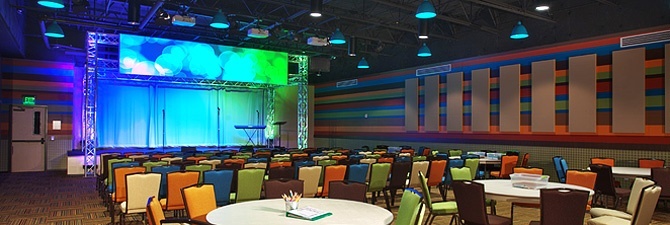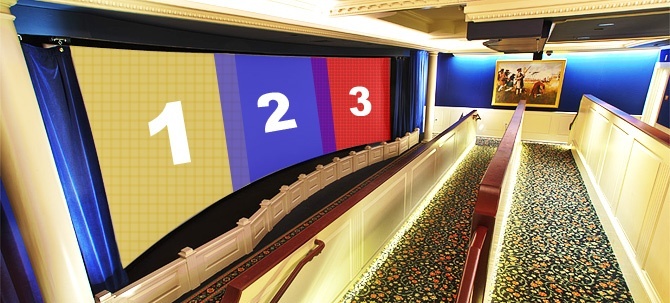What is Blended Projection?
Blended projection involves the use of multiple digital video projectors to produce a single, final projected image.

This example of blended projection uses three projectors and enables the client to project images in a venue with limited overhead space.
In a typical blended projection application, the images from two or more projectors are overlapped so that part of one image covers the other. Special techniques involving a combination of hardware and software are then applied to blend the images in the overlapping areas so that they produce a single, seamless image.
Why is blended projection used?
Applications for blended projection usually fall into one of two categories. First, where a non-standard screen format is desired, blended projection is an ideal approach. Screens can be as wide or tall as desired by simply adding additional images end-to-end. Atypical screen formats such as these are often found in museums, churches and specialty attractions that apply video as an artistic element in architectural design.

Boston’s Minuteman Theater used a three-projector blend to overcome extremely short throw distance and a low ceiling. The example illustrates how the images are overlapped.
The other primary use is to produce very large images with unusually high resolution. By adding the brightness and resolution of the individual projectors extraordinarily large images can be achieved for giant screen cinema and other specialty applications.
How does MediaMerge use this technology?
Blended projection can often provide a great solution for projection in spaces with limited ceiling height. By pushing elements out horizontally, more content can appear on a screen without increasing the screen’s reach upward.
Also, blended projection has application on curved screens and dome theaters where the unique geometry of the screen makes standard projection difficult.
One of the biggest drawbacks to blended projection is that the projectors have to remain perfectly aligned on the screen, otherwise the image drifts and causes ghosting and other undesirable artifacts. To address the alignment problem, MediaMerge developed the ShowSource media server’s camera-based auto-alignment system. The auto-alignment system uses a camera to scan the projected image and adjust each projector’s image so that the images on screen remain in perfect alignment.